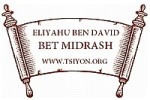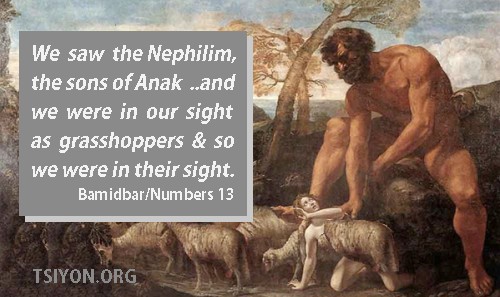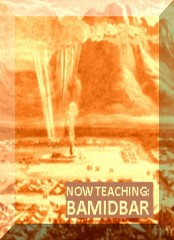Need to talk to us? - In the USA and Canada just call us toll free at (888) 230-2440 for help. Internationally, email us and we will arrange a phone or Skype call for you.
From Eliyahu
Hello friends,
Have you thought about giants lately?
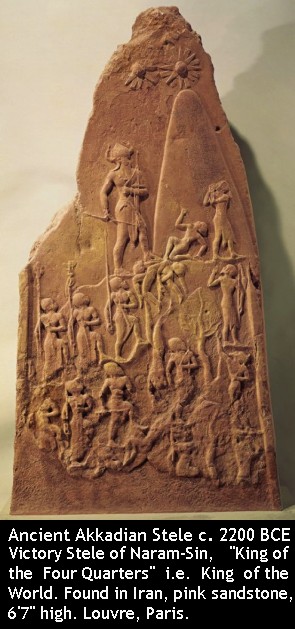 To
the left is a piece of artwork from the Ancient Near East now called "the
Victory Stele of Naram-Sin."
To
the left is a piece of artwork from the Ancient Near East now called "the
Victory Stele of Naram-Sin."
This large victory stele, six feet in height, was carved in pink limestone which has proven to be very durable over the millennia. The original text, written above King Naram-Sin in the Akkadian language, says this stele was made to celebrate the victory of the Akkadian empire, over the mountain people known as the Lullubi.
The king is clearly depicted as a giant on this stele. The prodigious scale of the king is interpreted by modern scholars as showing King Naram-Sin to be the most important figure in the picture. Everyone knows giants aren't real, so the extraordinary size must not be literal, right? Therefore, some clever device must be assumed to account for the large size.
Assumptions being what they are, I prefer to take the story told by this artwork at face value, as a realistic representation of what the artist actually saw - something like a news photo from over four thousand years ago.
Here is the story I see:
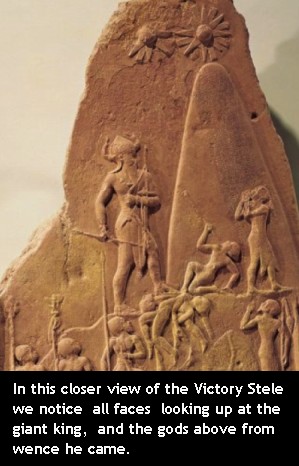 All
of the king's soldiers, and even his enemies, are looking up in the direction of
King Naram-Sin, a cruel giant taking a god-like stance on top of the mountain.
King Naram-Sin is shown wearing a helmet with bullhorns, further enhancing his
display of supernatural power.
All
of the king's soldiers, and even his enemies, are looking up in the direction of
King Naram-Sin, a cruel giant taking a god-like stance on top of the mountain.
King Naram-Sin is shown wearing a helmet with bullhorns, further enhancing his
display of supernatural power.
Actually, King Naram-Sin is himself shown looking up toward the gods, in the form of the stars above the mountain, and the people, groveling below, are taking in that whole scene of the king and the gods above. This suggests that the king is empowered by those star-gods, originating from them and one with them. The star-gods are not ancient aliens, as some imagine. But they are real nonetheless.
The Scriptures describe fallen
angels as fallen stars, and also tell us of fierce giants called Nephilim who
were the product of forbidden copulation between the fallen angels and the
daughters of men. The scene we see on the Victory Stele of Naram-Sin, the "king
of the world" agrees completely with the Biblical claims of kings of giant
stature in that ancient world. Most of us know that such Nephilim existed before
the Flood, and were destroyed by the Flood. However, the Biblical account which
introduces us to the Nephilim in the ante-deluvian world is careful not to leave
us with the impression that they were no more. The Nephilim were in the earth in those days (before the Flood), and also after
that, when God’s sons came in to men’s daughters. They bore children to them.
Those were the mighty men who were of old, men of renown. Gen 6:4
Of course, the offspring of angels, with superior size and strength, easily established themselves as kings over men; which well explains why so many of the very ancient depictions of kings represents some of them as giants.
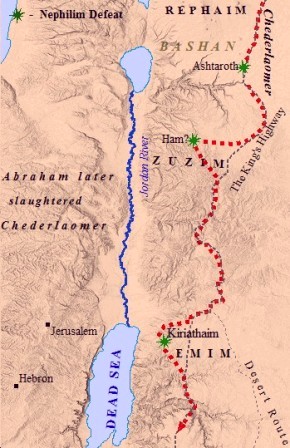 The Scriptures also tell us of
Nephilim kings. These are mentioned under other names, as in these verses:
The Scriptures also tell us of
Nephilim kings. These are mentioned under other names, as in these verses:
The Emim lived therein (in Moab) before, a people great, and many, and tall, as the Anakim: these also are accounted Rephaim, as the Anakim; but the Moabites call them Emim. Deut 2:10-11
There we saw the Nephilim, the sons of Anak, who come of the Nephilim: and we were in our own sight as grasshoppers, and so we were in their sight. Numbers 13:33
These and other verses seem to indicate a race of Nephilim arose sometime after the Flood. These were known as Rephaim. These were a giant race like the pre-flood Nephilim. The Rephaim produced other tribes known as Emim, Zuzim, Zamzummin, Anakim and possibly others. The Rephaim, the Anakim, Zamzummin, and Emim, are documented at least as far back as the time of Abraham. (See Gen 14:5 and map to right)
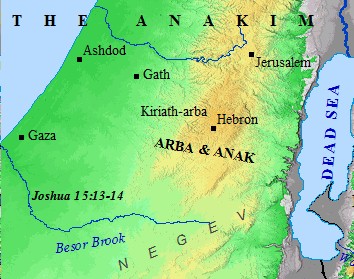 Their
early post-Flood roots seem to have been in Mesopotamia, but in time they
migrated in and around the land of Canaan. The greatest of them was known as
Arba, from whom sprang Anak and the Anakim. King Arba established Hebron as his
capitol city under the name of Kiriath-Arba. From there the Anakim spread out
across Canaan, eventually dominating and corrupting the entire population beyond
redemption, to such an extent that the entire population of Canaan, including
the giants, needed to be completely exterminated. YHWH tasked Israel with this
duty, under His protection, as a work of faith included with possessing the
Promised Land.
Their
early post-Flood roots seem to have been in Mesopotamia, but in time they
migrated in and around the land of Canaan. The greatest of them was known as
Arba, from whom sprang Anak and the Anakim. King Arba established Hebron as his
capitol city under the name of Kiriath-Arba. From there the Anakim spread out
across Canaan, eventually dominating and corrupting the entire population beyond
redemption, to such an extent that the entire population of Canaan, including
the giants, needed to be completely exterminated. YHWH tasked Israel with this
duty, under His protection, as a work of faith included with possessing the
Promised Land.
Clearly, the Israelites knew of the Anakim. Less than two years from the Exodus they stood on the brink of entering the Land of Canaan, when Elohim told them to go in and possess it. At that critical moment they hesitated, and prevailed upon Moses that they may be allowed to spy out the Land before finally committing to the task before them. This is where we take up the story in our latest EBD Bet Midrash, in Numbers 13. Be sure to tune in for more of this amazing story.
Blessings and Shalom,
Eliyahu ben David
________________________________________________________
Iran vows to attack Israel
from West Bank
Deputy head of Revolutionary Guards says Tehran to ‘open
new fronts’ in response to strike that killed Iranian general
January 24, 2015

Iran has threatened to attack Israel from the West Bank, in retaliation for an alleged Israeli airstrike in Syria on Sunday that left 12 Iranian and Hezbollah operatives dead. The airstrike has been attributed to Israel and though Jerusalem has not officially confirmed it, anonymous government sources have admitted as much.
Deputy head of Iran’s Revolutionary Guards Lt.-Gen. Hossein Salami vowed Saturday to “open new fronts [against Israel] and change the balance of power.” In an excerpt of an interview with Salami (photo:left), the IRGC’s number two said that Iran and Hezbollah would provide a “special reprisal” to the strike, according to the Tasnim News Agency, adding that opening a new front in the West Bank was in the works.
“Opening up a new front across the West Bank, which is a major section of our dear Palestine, will be certainly on the agenda, and this is part of a new reality that will gradually emerge,” Salami said in the inteview with Iran’s Arabic-language news channel al-Alam.
Iran and Hezbollah have issued a series of threats since the strike earlier this week, warning of a “crushing response,” and “destructive thunderbolts.” The dead included an Iranian general and senior Hezbollah commanders, Muhammad Issa and Jihad Mughniyeh, son of slain terror mastermind Imad Mughniyeh.
There have been conflicting reports as to whether Israel knew that Iranian general Mohammed Allahdadi was in the convoy.
On Friday, Channel 10 reported that Israel had sent calming messages to Iran and Hezbollah via Moscow after the strike, clarifying that it was uninterested in an escalating conflict with Tehran or the Lebanese terror group.
According to the report, Israeli officials told Moscow that Israel viewed the strike as an act of self-defense, and that Hezbollah had forced Israel’s hand by building an offensive infrastructure on its border. Jerusalem stressed it did not want the situation to deteriorate into a regional conflict. Russian leaders conveyed this message to Beirut and Tehran.
A report on Channel 2 Friday said the strike targeted the leaders of a substantial new Hezbollah terror hierarchy that was set to attempt kidnappings, rocket attacks and other assaults on military and civilian targets in northern Israel.
The new terror unit involved Mughniyeh, who was coordinating with the commander of the Quds Force of Iran’s Revolutionary Guards, Qasem Soleimani, the Channel 2 report said. There was no suggestion in the report that Soleimani, a key figure in supporting Syrian President Bashar Assad and Hezbollah, was in the area at the time.
The terrorist hierarchy included recruitment and intelligence departments, and was set to begin operations targeting Israel from the Syrian Golan, including “kidnappings, firing rockets and mortar shells, and using anti-tank weapons against Israeli residential areas.”
The unit was set up “with Iranian sponsorship,” the report said. Israel’s targeting of some of its members underlined that “a red line was crossed that Israel would not tolerate.”
The TV report said Israel was braced for a response. If that response targeted Israeli civilians, however, subsequent Israeli retaliation would endanger the Assad regime in Syria, Channel 2’s military commentator Roni Daniel said. He did not state a source for that assertion.
______________________________________________
Need to talk to us? - In the USA and Canada just call us toll free at (888) 230-2440 for help. Internationally, email us and we will arrange a phone or Skype call for you.
